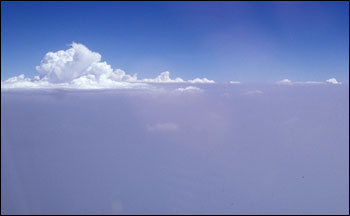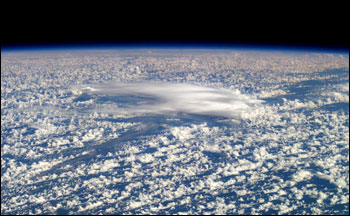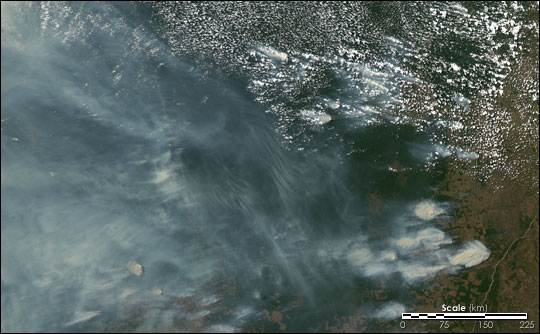

 | |||
Not long after arriving at NASA’s Goddard Space Flight Center, Ilan Koren reached a dead end in his first research project, or so it seemed. He was trying to find satellite images over the Amazon rainforest showing heavy smoke from burning vegetation mingling with low-level cumulus clouds. Once he found such scenes, Koren’s second objective was to use the satellite data to observe and measure how the smoke particles altered the clouds. The problem was that after spending days combing through NASA’s Terra and Aqua data sets, Koren could not find enough examples of smoke mingling with low-level cumulus clouds. |
|||

It was November 2002, and Koren had arrived at NASA only 3 months earlier, having just received his doctorate degree from the University of Tel Aviv, where he studied clouds. In school, Koren loved delving into the mysteries of how and why clouds form and change over time. On one level, he appreciated clouds for their beauty. On a deeper level, he recognized their power—clouds regulate the flow of radiant energy into and out of Earth’s climate system. “They are nature’s way of drawing in the sky the physics of what exactly is going on in the air,” he said. “If you can reduce their shapes and patterns to numbers and plug them into mathematical formulas, perhaps you can predict the weather, or even forecast changes in the climate.” |
Smoke, interspersed with a few clouds, obscures the Brazilian landscape in this photograph. Ground-breaking NASA research is revealing new connections between smoke and the formation of clouds over the Amazon rainforest. These interactions alter the amount of sunlight reflected by the Earth, and may influence climate on a global scale. (Photograph courtesy USDA Forest Service Brazilfire) | ||

This insight led Koren to focus his doctorate research on clouds. If he could help solve the physics problems of how and why clouds form and change over time, he could give the science community a key missing piece of the larger climate change puzzle: how much radiant energy do clouds trap within Earth’s atmosphere and how much do they reflect back out into space? Because there are so many different types of clouds, and because they form, move, change, and dissipate so rapidly over time and space, it is a difficult question to answer. NASA satellite technology has helped to carry cloud research forward in great leaps over the last several decades, and has revealed that as environmental conditions change, so too do clouds and their roles within the climate system. If scientists can’t get the cloud physics right in their models, they cannot predict how cloud changes will affect Earth’s total energy budget, and therefore they cannot accurately predict future climate change. So, filled with enthusiasm, Koren came to NASA to join a team of physical scientists, led by Yoram Kaufman and Lorraine Remer, studying one particular way in which cloud changes influence climate. When tiny particles of pollution in the air (called “aerosols”) mingle with certain kinds of clouds they change the clouds’ properties, making them whiter, more reflective, and longer lasting, which enhances their ability to shade and cool the surface below them. Dubbed the “indirect effect of aerosols,” Kaufman and Remer wanted to find out just how much brightening and prolonging clouds enhanced their ability to reflect sunlight back to space. They were using a new instrument called the Moderate Resolution Imaging Spectroradiometer (MODIS) that NASA had launched aboard both its Terra and Aqua satellites. Because it sees almost the entire surface of Earth every day, across a wide portion of the color spectrum, MODIS is an ideal tool for studying clouds and aerosols. Koren was very excited to work at NASA on such an interesting and important scientific problem, using some of the most advanced satellite technology in the world. Only, now that he had the opportunity, after days of searching he could not find enough examples in the data showing low-level cumulus clouds mingling with smoke plumes. |
Clouds help regulate the Earth’s climate by reflecting sunlight into space, thus cooling the surface. When cloud patterns change, they modify the Earth’s energy balance in turn, and temperatures on the Earth’s surface. (NASA Astronaut Photograph ISS009-E-8627) | ||
 | |||
“Specifically, I was looking for a ‘well-behaved’ cloud field,” Koren recalled. “The clouds had to sit on the same layer of atmosphere at roughly the same height. Also, they had to be the same in their convective properties. The clouds all had to be the same type, same size, same distance between them, and the same in their meteorological properties, both inside and outside the smoke.” |
Satellite images of the Amazon rainforest rarely show smoke and cumulus clouds together. Smoke, mainly from agricultural fires, displaces the cumulus clouds that normally form above the forest each afternoon. (NASA image by Jesse Allen and Robert Simmon) | ||
 | |||
The Amazon Basin was the perfect place to look. Every day, the skies over the rainforest produce widely scattered cumulus clouds sitting at the top of the boundary layer—the layer of atmosphere from the surface to anywhere from 1 to 3 kilometers high. These cumulus clouds are all about the same size, they are distributed in a very uniform way with good spacing in between, and they cover most of the Amazon jungle during the dry season in the afternoon. Moreover, during the dry season there from August through October, there are typically hundreds of intense fires burning across the region, producing thick plumes of smoke traveling for hundreds of kilometers. These were perfect conditions for studying how smoke affects clouds. “Amazonia was almost too good to be true,” Koren said. “All I had to do was find areas where there was heavy smoke and these clouds. And it was puzzling that I could not find smoke and clouds together.” | A uniform layer of scattered cumulus clouds is typically present, along with some thunderstorms, over the Amazon rainforest. Compare this image of a day with little smoke, with the image above. Both images were acquired by the Moderate Resolution Imaging Spectroradiometer aboard NASA’s Aqua satellite, on August 11 (top) and November 15 (bottom), 2002. (NASA image by Jesse Allen and Robert Simmon) | ||
Could the smoke somehow be suppressing the formation of clouds? Koren suspected the smoke was to blame. They noted that the disappearance of the clouds in the presence of the smoke reminded them of observations made by V. Ramanathan thousands of miles away in the Indian Ocean. During an experiment there, Ramanathan noticed that as he flew above the smoke he did not see many clouds. But in the south, beyond the reach of the smoke, clouds did exist. Was this cloud pattern due to differences in the meteorology of the region or due to the effect of smoke? At this point Koren changed the focus of his research to seek answers to these questions. He began by turning to the scientific literature to see if any other scientists had observed the same phenomenon and provided an explanation. |
The data used in this study are available in one or more of NASA's Earth Science Data Centers. | ||